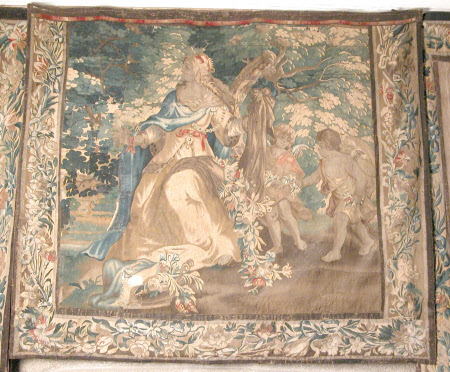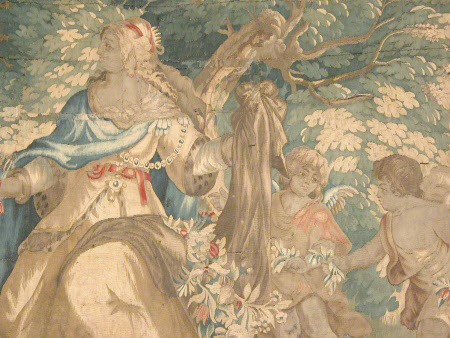Circe
Wauters, Cockx and de Wael
Category
Tapestries
Date
circa 1680 - circa 1700
Materials
Tapestry, wool and silk, 7 warps per cm
Measurements
1800 x 1560 mm
Place of origin
Antwerp
Order this imageCollection
Cotehele, Cornwall
NT 348248.2
Summary
Tapestry, wool and silk, 7 warps per cm, Circe, fragment from King Picus Hunting from a set of four of the Story of Circe, Antwerp, c. 1680-1700. Circe, wearing a faded dress with fur-lined sleeves, a blue cloak, jewelled necklace and a small crown in her blond hair, is seated in the centre of the tapestry, her arms raised slightly in surprise as she looks out to the right. In her proper left hand she holds one side of her apron, and herbs and flowers tumble down from it onto the ground, while behind her to the right two winged putti carry more bunches of herbs. The setting is a wooded landscape with a pool to the left. The tapestry has a border composed of leaves, flowers and blue ribbons around three sides, and a narrow border of a red and white ribbon attached to a brown galloon at the top. Only the right-hand border is integral to the tapestry and the others have been attached from unrelated pieces.
Full description
This tapestry shows the sorceress Circe, and originally formed part of a larger panel of ‘Picus and Circe’, part of which, showing King Picus, hangs in the Dining Room at Cotehele (348248.1). Other weavings of the same design show the whole composition. Circe was a sorceress, the daughter of the sun God Helios, and lived on the island of Aeaea off the west coast of the Italian peninsular. She is best known for her encounter with Ulysses and his men on their journey home from the Trojan War, and two small tapestry fragments at Cotehele relate to these events (348248.3, 4). The story of her meeting with Picus is told in Ovid’s Metamorphoses, and was apparently related by one of Circe’s attendants to Ulysses’s companions. Circe was in Latium, gathering magical herbs in the woods, when she saw the young King Picus out hunting. Circe was so struck with his beauty that she dropped her handfuls of herbs; the tapestry shows her in this attitude of surprise, with herbs and flowers falling from her apron. The two winged putti behind Circe helping her to gather herbs do not appear in Ovid’s narrative. Circe then tried to seduce Picus – for which see the catalogue entry for 348248.1. The narrow upper border on this panel composed of a red and white ribbon is taken from a set of ‘Liberal Arts’, an example of which hangs behind the bed in the Red Room. A watercolour by Nicholas Condy of c. 1840 shows this tapestry hanging over the fireplace in the Punch Room (then known as the Ante Room). The four tapestries at Cotehele form part of a larger series of ‘The Story of Circe’. In 1682 the Antwerp firm of Wauters, Cocx and de Wael bought from the stock of the deceased Michiel Wauters seven cartoons in of the Story of Circe by ‘Spirinck and Eyckens’ (Denucé 1936, p. 98). Michiel Wauters, who died in 1679, is not known to have produced any tapestries after these cartoons, but between 1682 and 1698 Wauters, Cocx and de Wael produced numerous editions of the set, which seem to have been aimed almost exclusively at the English market (Delmarcel and van Tichelen 1996, pp. 61-66). Although the original set of cartoons included seven subjects, most of the sets sold had only six, which are named in the various documents and can be identified as follows: ‘The Companions of Ulysses arriving at the Palace of Circe’; ‘Circe offering a magic Potion to one of Ulysses’ Companions’; ‘Mercury showing Ulysses the way to Circe’s Palace’; ‘An attendant of Circe showing the marble statue of Picus to one of Ulysses’s Companions’; ‘Circe failing to bewitch Ulysses’; and ‘Picus Hunting on Horseback’. The seventh subject is not named but may have been ‘Picus refusing Circe’, the design taken from a print by Antonio Tempesta, an example of which survives at Uppark (Hefford 1983, fig. 27). A set of six was sold in 1995, and various other partial sets have appeared on the art market or are in private collections (de Meûter 2003, p. 137; Delmarcel and van Tichelen 1996, pp. 61-66). At Cotehele there are small fragments from ‘The Companions of Ulysses arriving at the Palace of Circe’ (348248.3) and ‘Circe failing to bewitch Ulysses’ (348248.4), and two larger fragments from ‘Picus Hunting’ (348248.1, 348248.2). Only the fragment representing ‘Circe’ at Cotehele has remnants of its original border, composed of leaves and flowers tied with ribbons on a brown ground. A very similar border can be seen on the ‘Children’s Games’ tapestries which hang in the Red Room, and which were woven by Philip Wauters, Michiel Wauters’s brother. The cartoons for the set were described in 1682 as by ‘Spirinck and Eyckens’. Pieter Spierinckx was an Antwerp painter who contributed to at least 15 sets of tapestry designs for the major Antwerp tapissiers and entrepreneurs in the late 17th and early 18th centuries. His oeuvre has recently been examined by Ingrid de Meûter (de Meûter 2001; 2003). Spierinckx was highly regarded as a landscape artist and was often called upon to collaborate with others by providing landscape backgrounds as a setting for figures, still lives and so on, both in paintings and tapestry designs. On the ‘Circe’ tapestries his collaborator is described as ‘Eyckens’, which could refer to either Jan Ijkens (1613-1679) or his son Pieter (1648-1695), both of whom were active as painters and tapestry designers in Antwerp; on stylistic grounds de Meûter has attributed the figures in the ‘Circe’ series to the father, Jan (de Meûter 2003, p. 137). (Helen Wyld, 2010)
Provenance
First recorded at Cotehele c. 1840; left at Cotehele when the property was accepted in lieu of tax from Kenelm, 6th Earl of Mount Edgcumbe (1873-1965) and transferred to the National Trust in 1947; amongst the contents accepted in lieu of estate duty by H M treasury and transferred to the National Trust in 1974.
Credit line
Cotehele House, The Edgcumbe Collection (The National Trust)
Makers and roles
Wauters, Cockx and de Wael , workshop possibly Maria Anna Wauters (c.1656 - 1703), workshop Pieter Spierinckx (1635 - 1711), designer attributed to Jan Ijkens (Antwerp, 1613 - 1679), designer
References
de Meûter, 2001: Ingrid de Meûter, 'L'oeuvre reconstitué du peintre anversois Pieter Spierinckx (1635-1711), créateur de cartons de tapisseries', Bulletin des Musées royaux d'art et d'histoire vol. 72 (2001), pp. 121-152 de Meûter, 2003: Ingrid De Meûter, 'Le peintre anversois Pieter Spierinckx,1635-1711, créateur de cartons de tapisserie', in Koenraad Brosens (ed.), Flemish tapestry in European and American Collections, Turnhout 2003, pp.133-152 Delmarcel and van Tichelen, 1994: Guy Delmarcel and Isabelle van Tichelen, ‘La tapisserie des Pays-Bas Meridionaux sous l’Ancien Régime’, in Les Fresques Mobiles du Nord: Tapisseries de nos regions: XVIe – XXe siècle, exh. cat. Antwerp 1994 Hefford, 1983: Wendy Hefford, ‘The Chicago Pygmalion and the “English Metamorphoses”’, The Art Institute of Chicago: Museum Studies, 10 (1983), pp. 93-117 Marillier, 1940: Henry C Marillier, ‘The English Metamorphoses: a confirmation of origin’, Burlington Magazine, vol. 76, no. 443 (Feb. 1940), pp. 60-63 Denucé, 1936: Jean Denucé, Antwerpsche tapijtkunst en handel, Antwerp 1936 Denucé, 1931: Jean Denucé, Kunstuitvoer in de 17e eeuw te Antwerpen: de firma Forchoudt, Antwerp 1931

